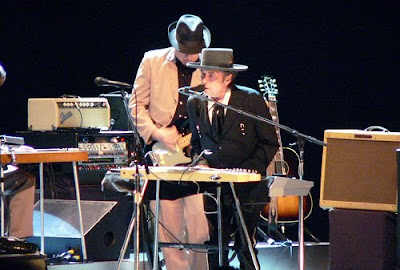I lost my camera. Perfect timing. The last two events that I would have wanted to have photographed both prohibited cameras anyway. The first was a pueblo feast day (tomorrow's post). The second was last night’s concert. Since there are photos in this post, I've obviously and without scruples picked and plucked from around the Web. (Which I'll probably continue to do until I find or replace my camera.)

Opening act at 5:30 were TheWiyos, a sort of Cajun-influenced Squirrel Nut Zippers with a front man whose body antics made it apparent that he misses vaudeville. Willie Nelson followed. The 77-year old pot-promoting man still has a fantastic voice and is quite amazing on the guitar. He was the only lead, but as my friend said, “I kept looking for another guitar there was so much sound coming from him.” (Check out the wear and tear on the guitar!)


Then John Mellencamp blazed onto the stage. Short, and probably with a Napolean complex, this guy projects attitude to the back of the lawn seats. Just pure rock n roll, complete with staged choreography of all four guitars fronting the lip of the stage as the electric violin and accordion players wove in and out. The drummer had enough crispness and volume to match Nelson’s guitar. Mellencamp built a great wall of sound, pounding out mostly classics, one a capella, and one new one that was recorded during this tour.
Then came the act which had attracted me: Bob Dylan. As far as I can remember, this was my eighth Dylan show, and it was among the top three performances. He seemed to take energy from the three previous acts and actually enjoy himself. He even struck a pose from time to time while playing harmonica.
I also realized that a lot of people want to
see Dylan, but they don't really like his music or want to hear it. About a third of the folks left after his first song. Gravely and often undecipherable words is not everyone's idea of music. But I enjoy coming to a concert to see how he lets his voice become part of the sound of the music. He doesn't focus on being the front man with the voice. Instead, I find that his concerts are explorations of textures.
Dylan opened with “Mr. Jones” and moved on to such a grooving rock interpretation of “It’s Alright Ma” that, even after it was finished, I still wasn’t sure what I had heard but knew that I liked it—a lot. I wish that I had a copy of last night’s rendition of “Highway 61.” The innovation and re-interpretation of his own music is what makes a Dylan concert so interesting. He opens up the music and you can see him as the great conductor improvising on the spot with his impeccable responding with on-the-spot precision. He closed with “All Along the Watchtower.” I’ve heard him do this one before, and tended to like the Hendrix and Bono versions better. But last night, Dylan made it clear that he owns this song. It was dark and mysterious as his pacing of lyrics and progressive chord structures emphasized the emotion of the song.
The sky was a soft, pastel blue. The air cooled with a fiery-orange sunset. The wind added adrenalin as it billowed through the huge stage curtains. I was outside listening to Bob Dylan, Willie Nelson and John Mellencamp for 5 hours.
Need I say more?













